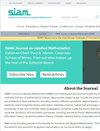Finite Population Size Effects on Optimal Communication for Social Foragers
IF 2.1
4区 数学
Q1 MATHEMATICS, APPLIED
引用次数: 0
Abstract
SIAM Journal on Applied Mathematics, Volume 84, Issue 3, Page 915-939, June 2024.Abstract. Foraging is crucial for animals to survive. Many species forage in groups, as individuals communicate to share information about the location of available resources. For example, eusocial foragers, such as honey bees and many ants, recruit members from their central hive or nest to a known foraging site. However, the optimal level of communication and recruitment depends on the overall group size, the distribution of available resources, and the extent of interference between multiple individuals attempting to forage from a site. In this paper, we develop a discrete-time Markov chain model of eusocial foragers, who communicate information with a certain probability. We compare the stochastic model and its corresponding infinite population limit. We find that foraging efficiency tapers off when recruitment probability is too high, a phenomenon that does not occur in the infinite population model, even though it occurs for any finite population size. The marginal inefficiency at high recruitment probability increases as the population increases, similar to a boundary layer. In particular, we prove there is a significant gap between the foraging efficiency of finite and infinite population models in the extreme case of complete communication. We also analyze this phenomenon by approximating the stationary distribution of foragers over sites in terms of mean escape times from multiple quasi-steady states. We conclude that, for any finite group of foragers, an individual who has found a resource should only sometimes recruit others to the same resource. We discuss the relationship between our analysis and multiagent multiarm bandit problems.
有限种群规模对社会性觅食者最佳交流的影响
SIAM 应用数学杂志》第 84 卷第 3 期第 915-939 页,2024 年 6 月。 摘要觅食是动物生存的关键。许多物种都是群体觅食,个体之间通过交流分享有关可用资源位置的信息。例如,蜜蜂和许多蚂蚁等群居觅食者会从中心蜂巢或巢穴招募成员到已知的觅食地点。然而,交流和招募的最佳水平取决于整个群体的规模、可用资源的分布以及试图从一个地点觅食的多个个体之间的干扰程度。在本文中,我们建立了一个离散时间马尔可夫链模型,该模型是以一定概率进行信息交流的群居觅食者。我们比较了随机模型及其相应的无限种群极限。我们发现,当招募概率过高时,觅食效率会逐渐降低,而这一现象在无限种群模型中不会出现,尽管在任何有限种群规模下都会出现。随着种群数量的增加,高招募概率下的边际无效率也会增加,类似于边界层。特别是,我们证明了在完全交流的极端情况下,有限种群模型和无限种群模型的觅食效率存在明显差距。我们还用多个准稳定状态的平均逃逸时间来近似分析觅食者在各个地点的稳定分布,从而分析了这一现象。我们的结论是,对于任何有限的觅食者群体来说,找到资源的个体有时只会招募其他人来获取相同的资源。我们将讨论我们的分析与多代理多臂强盗问题之间的关系。
本文章由计算机程序翻译,如有差异,请以英文原文为准。
求助全文
约1分钟内获得全文
求助全文
来源期刊
CiteScore
3.60
自引率
0.00%
发文量
79
审稿时长
12 months
期刊介绍:
SIAM Journal on Applied Mathematics (SIAP) is an interdisciplinary journal containing research articles that treat scientific problems using methods that are of mathematical interest. Appropriate subject areas include the physical, engineering, financial, and life sciences. Examples are problems in fluid mechanics, including reaction-diffusion problems, sedimentation, combustion, and transport theory; solid mechanics; elasticity; electromagnetic theory and optics; materials science; mathematical biology, including population dynamics, biomechanics, and physiology; linear and nonlinear wave propagation, including scattering theory and wave propagation in random media; inverse problems; nonlinear dynamics; and stochastic processes, including queueing theory. Mathematical techniques of interest include asymptotic methods, bifurcation theory, dynamical systems theory, complex network theory, computational methods, and probabilistic and statistical methods.

 求助内容:
求助内容: 应助结果提醒方式:
应助结果提醒方式:


